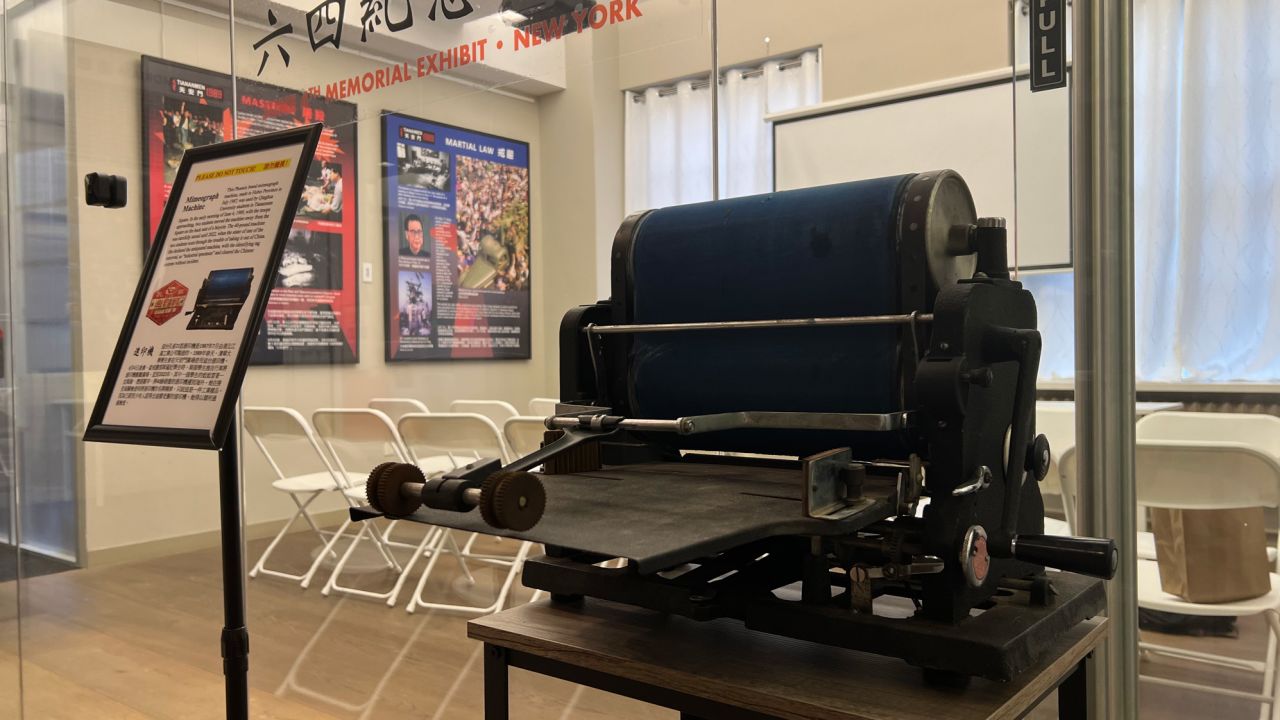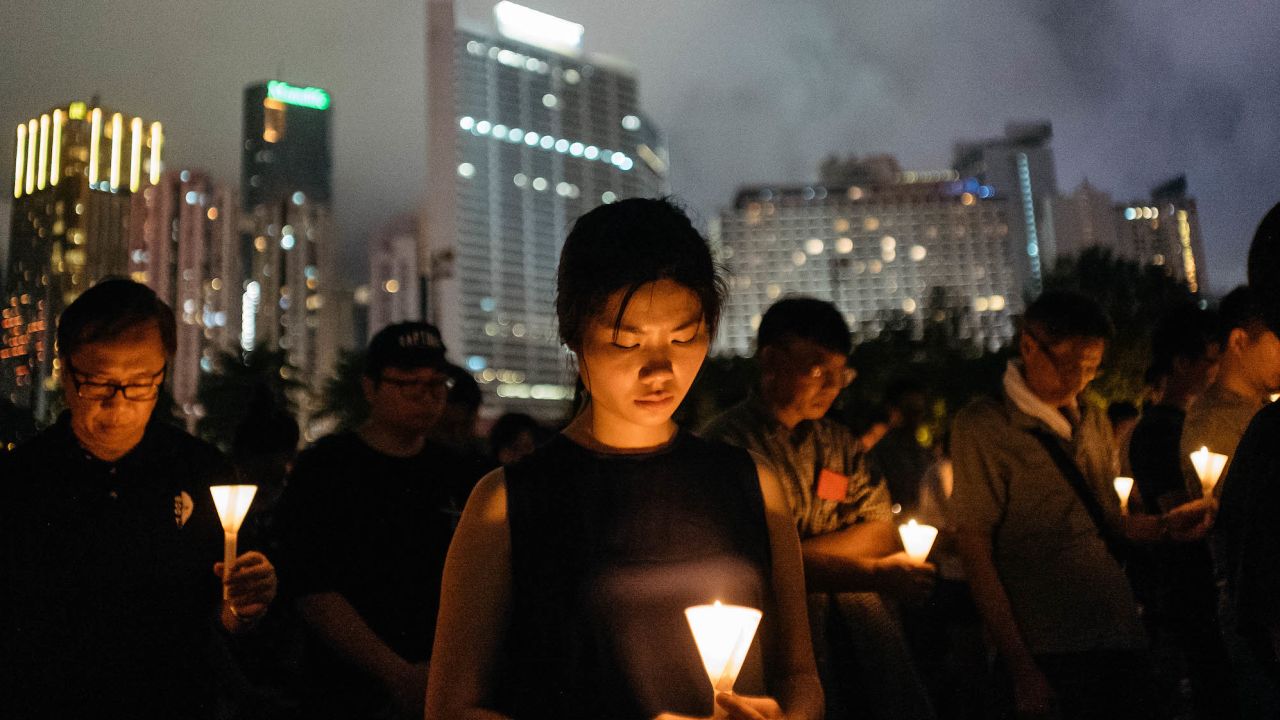Hong Kong
CNN
—
Hong Kongers living overseas are helping to keep the flame of remembrance alive for the victims of China’s Tiananmen massacre as authorities in a city that once hosted huge annual vigils continue to stamp out dissent.
Until recently Hong Kong was the only place within China where large-scale gatherings each June 4 were tolerated to remember the moment in 1989 when the Communist Party sent tanks in to violently quell peaceful student-led democracy protests in Beijing’s Tiananmen Square.
But the annual candlelight vigils have been silenced the last three years in the wake of pandemic restrictions and Beijing’s ongoing political crackdown in Hong Kong, which was upended by its own huge democracy protests in 2019.
This year is set to be no different. As a result, it is overseas where the most concerted commemorations were taking place for the 34th anniversary.
Protests, vigils and exhibitions are planned in multiple cities around the world including in Australia, Japan, Taiwan, Europe, the United States and Canada bolstered by a growing cohort of Hong Kongers who have chosen to move overseas.
“I think it’s sad to say that what Beijing and Hong Kong are doing is trying to erase history and the memory,” said Kevin Yam, a former lawyer in Hong Kong, who will be attending a ceremony in Melbourne, Australia, where he now resides.
“For those who can still remember, we have the obligation to let the world know that we have not forgotten,” he told CNN.
A new museum in New York is a vivid example of how Tiananmen commemorations are going global.
On Friday, Zhou Fengsuo and Wang Dan, two former student leaders who took part in the 1989 Tiananmen protests and now live in the United States, unveiled a June 4th Memorial Exhibit on 6th Avenue.
The display includes items collected from those who survived the massacre including newspapers chronicling the event, a blood-stained shirt from a former journalist and a decades-old printer used by protesters that was sneaked out of China.
Zhou said the idea to create a New York exhibition began five years ago but the closure of Hong Kong’s own June 4 museum by authorities in 2021 “added to the urgency”.
“Hong Kong has been carrying the torch for commemorating the Tiananmen massacre, keeping the legacy alive. When the museum was shut down, with the Hong Kong alliance’s leaders in prison, we knew it was a critical moment,” he said.
“We have to continue here in the United States.”
The 2,200-square-feet venue in New York can host up to 100 guests at a time, with schools and universities already reaching to request for a tour, Zhou said, adding they have raised enough funding to keep it running for “many years”.

Thirty four years ago, Beijing sent in People’s Liberation Army troops armed with rifles and accompanied by tanks to forcibly clear the square where students were protesting for greater democracy.
No official death toll is available, but estimates range from several hundred to thousands, with many more injured.
Authorities in mainland China have always done their best to erase all memory of the Tiananmen massacre: Censoring news reports, scrubbing all mentions from the internet, arresting and chasing into exile the organizers of the protests, and keeping the relatives of those who died under tight surveillance.
The censorship has meant generations of mainland Chinese have grown up without knowledge of the events of June 4.
But Hong Kong was different.

Somber and defiant vigils were an annual political cornerstone, first under colonial British rule and then after the city’s 1997 handover to China. Every June 4, come rain or shine, tens of thousands of people would descend on Victoria Park with speakers demanding accountability from the Chinese Communist Party for ordering the bloody military crackdown.
But Hong Kong’s political culture has changed drastically in the aftermath in 2019’s huge and sometimes violent democracy protests.
Beijing responded with a sweeping national security law that outlawed most dissent. Leading democracy activists, including key Tiananmen vigil figures, have been jailed, critical newspapers shuttered and the political system overhauled to ensure only “patriots” are allowed.
Authorities banned the vigil in 2020 and 2021 citing coronavirus health restrictions – though many Hongkongers believe that was just an excuse to clamp down on shows of public dissent.
Last year, the park remained in darkness again, barricaded off on all sides with police stopping and searching passersby to “prevent any unauthorized assemblies which affect public safety and public order, and to prevent the risk of virus transmission due to such gatherings,” according to a government statement.
The Hong Kong Alliance, the group behind the past vigils, has disbanded with three leading figures in jail facing national security charges.
In the run up to this Sunday’s anniversary, authorities made clear commemorating Tiananmen this year would not be tolerated.
Security secretary Chris Tang – a former police chief – said he expected some might use “this very special day” to advocate Hong Kong independence and subvert state power, acts banned by the new national security law.
“But I want to tell these people that if you carry out these acts, we will definitely take decisive action,” he warned, adding: “You will not be lucky.”
Hong Kong police maintained a heavy police presence around the park on the anniversary’s eve, deploying multiple police coaches and even an armored vehicle at one point.
A handful of artists and activists defied warnings and turned up either at the park or surrounding streets on Saturday evening to make private commemorations with floral tributes and banners, only to be quickly intercepted and taken away by officers.
A police spokesman said four people were arrested on suspicion of disorderly behavior in public or carrying out acts with seditious intent as of Saturday. Police said some individuals had protest props bearing allegedly “seditious” wording. Four others were brought in for further investigation, police added.
Richard Tsoi, former secretary for the now-defunct Hong Kong Alliance, said he planned to commemorate the event either at home or at a private location.
“Definitely there will be not be large-scale commemoration activities. Whether one can mourn in public without breaking the law is also a question,” said the ex-organizer, who used attend every vigil in the past.
Throughout Hong Kong physical reminders of the Tiananmen massacre, including a famous “Pillar of Shame” statue that used to stand in the city’s oldest university, have been dismantled in recent years.
Yet last month a replica of the “Pillar of Shame” was erected in Berlin, with the help of its original Danish artist Jens Galschiot and a prominent Hong Kong activist now living in Germany. The artist also provided more than 40 giant banners printed with an image of the pillar to 18 cities for their commemoration events, including Los Angeles and Boston.
Another pillar was unveiled in Norway last year.
“It is true that the commemorations around June 4th have expanded and become more global since it has become impossible to do anything in Hong Kong,” he told CNN.
Hong Kongers, Zhou says, are playing a key role in keeping Tiananmen remembrance alive overseas,
“Since last year, many places have seen record numbers in attendance largely because of Hong Kong immigrants,” he said.
Many Hong Kongers have left for overseas with the city’s population dropping from 7.41 million to 7.29 million last year.
In Britain – where more than 100,000 Hongkongers have since settled after London offered an easier pathway to citizenship two years ago – about a dozen marches and vigils are slated to take place throughout June 4 across the country, from Nottingham and Manchester, a popular destination for Hong Kong immigrants.
In London, marchers will gather at Trafalgar Square before marching to the Chinese embassies, where a vigil will be held.